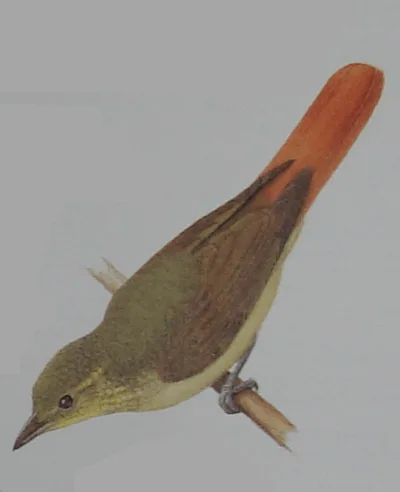
Rufous-tailed Foliage-Gleaner
[order] Passeriformes | [family] Furnariidae | [latin] Philydor ruficaudatum | [UK] Rufous-tailed Foliage-Gleaner | [FR] Anabate rougequeue | [DE] Olivrucken-Blattspaher | [ES] Ticotico Colirrufo | [IT] Ticotico codarossiccia | [NL] Roodstaart-bladspeurder
Subspecies
| Genus | Species | subspecies | Breeding Range | Breeding Range 2 | Non Breeding Range |
| Philydor | ruficaudatum | SA | Amazonia | ||
| Philydor | ruficaudatum | flavipectus | |||
| Philydor | ruficaudatum | ruficaudatum |
Physical charateristics
Upperparts mainly olive with crown feathers egded dsuk and faint yellow. Eyebrow stripe, chin and throat buffy yellow, primaries dusky with tail olive. Underparts olive yellow, somewhat darker on breast and flanks. Sexes are similar.
Listen to the sound of Rufous-tailed Foliage-Gleaner
[audio:http://www.aviflevoland.nl/sounddb/R/Rufous-tailed Foliage-Gleaner.mp3]
Copyright remark: Most sounds derived from xeno-canto
| wingspan min.: | 0 | cm | wingspan max.: | 0 | cm |
| size min.: | 16 | cm | size max.: | 17 | cm |
| incubation min.: | 0 | days | incubation max.: | 0 | days |
| fledging min.: | 0 | days | fledging max.: | 0 | days |
| broods: | 0 | eggs min.: | 0 | ||
| eggs max.: | 0 |
Range
Found in Bolivia, Brazil, Colombia, Ecuador, Peru, Venezuela and the Guianas. In Suriname only a few observations from the interior.
Habitat
Lowland evergreen subtropical or tropical moist forests.
Reproduction
No datra available.
Feeding habits
Diet consists of a variety of insects including bugs and spiders. Forgaes in mid level foliage and canopy. Usually hunts in pairs or mixed flocks, gleaning predominantly at dead leafs.
Conservation
This species has a large range, with an estimated global extent of occurrence of 4,100,000 km2. The global population size has not been quantified, but the species is not believed to approach the thresholds for the population size criterion of the IUCN Red List (i.e., less than 10,000 mature individuals in conjunction with appropriate decline rates and subpopulation qualifiers), even though the species is described as ‘uncommon’ in at least parts of its range (Stotz et al. 1996). Global population trends have not been quantified, but the species is not believed to approach the thresholds for the population decline criterion of the IUCN Red List (i.e., declining more than 30% in ten years or three generations). For these reasons, the species is evaluated as Least Concern.

Migration
Sedentary throughout range.
Distribution map

]]>
